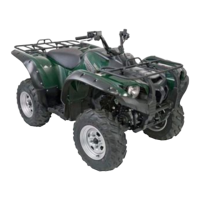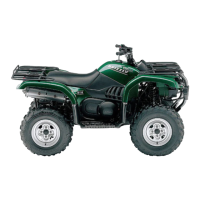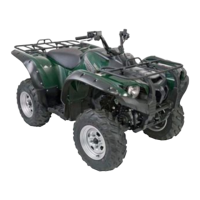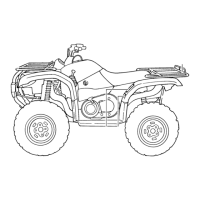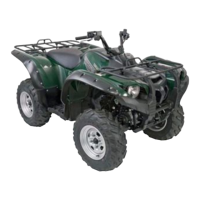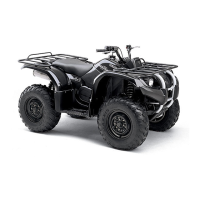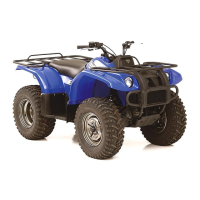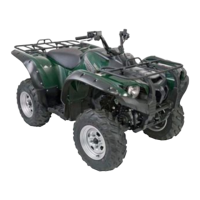
Do you have a question about the Yamaha ULTRAMATIC GRIZZLY 660 YFM660FR and is the answer not in the manual?
| Brand | Yamaha |
|---|---|
| Model | ULTRAMATIC GRIZZLY 660 YFM660FR |
| Category | Offroad Vehicle |
| Language | English |
Record key, vehicle, and model label information for ordering spare parts or reference.
The key identification number is stamped on the key and used for ordering a new key.
The vehicle identification number is stamped into the frame and used to identify your machine.
The model label is affixed to a specific location. Record its information for ordering spare parts.
Functions of the respective switch positions ON and OFF. The key can be removed in OFF position.
Explanation of various indicator lights such as differential lock, low range, high range, neutral, reverse, park, 4WD, and coolant temperature warning.
The unit displays riding speed, odometer, tripmeters, clock, and hour meter.
Indicates fuel level and includes fuel tank cap and fuel cock operation.
Covers light switch, engine stop switch, start switch, horn switch, and 4WD/differential lock selectors.
Selects drive mode (2WD/4WD) and differential gear lock (LOCK/4WD) based on terrain and conditions.
Regulates engine speed by varying throttle position. Returns to idle when released.
Keeps throttle from fully opening, limiting maximum engine power and speed.
Instructions for operating front brake lever, rear brake pedal, and lever.
Used to shift into low, high, neutral, reverse, and park positions.
Firmly grasp handle, pull slightly until engagement felt, then pull forcefully without pulling rope all the way out.
Covers fuel tank cap, fuel cock, and starter (choke) operation.
Procedures for seat removal/installation, storage compartment, and front/rear carriers.
Spring preload can be adjusted to suit rider's weight and riding conditions.
Located at the front right side. Use for accessories. Use only when engine is running.
Check operation, free play, fluid level, and leakage. Inspect pads for wear and correct if necessary.
Ensure sufficient gasoline in the tank. Recommended fuel type and tank capacity.
Check oil level and fill as necessary. Recommended oil types and quantities.
Check coolant level and add if low. Change coolant every two years.
Check for oil leakage. Recommended SAE 80 API GL-4 hypoid gear oil.
Check oil level and add as necessary. Recommended SAE 80 API GL-4 hypoid gear oil.
Check for smooth operation and return to idle. Adjust engine idling speed before adjusting free play.
Always use recommended tires. Check tire pressure, wear, and damage. Includes tire wear limit.
Check tightness of chassis fittings and fasteners before a ride. Refer to Service Manual for torque.
Check headlights and tail/brake light for proper operation. Repair as necessary.
Check protective boots for holes or tears. Replace damaged boots.
Ensure control cables work smoothly, apply rear brake, turn fuel cock ON, main switch ON, engine stop switch ON.
Refer to cold start section. Starter (choke) not used. Open throttle slightly.
Warm up engine before starting off. Never accelerate hard with a cold engine.
Shift before shifting: stop machine, return throttle to closed. Apply brakes, then shift lever.
Important period (0-20 hours). Avoid excessive load. Wear and polish parts for correct clearances.
Stop engine, shift drive select lever to park, turn fuel cock to OFF.
Avoid parking on hills. If necessary, park transversely, apply parking brake, block wheels.
Choose genuine Yamaha accessories. Mount securely. Consider load limits for cargo and trailers.
This ATV is for utility and recreation. Learn basic techniques before difficult maneuvers.
Get training if inexperienced. Familiarize with ATV at slow speeds. Do not operate at maximum performance until familiar.
ATV is designed for off-road use only. Riding on paved surfaces can cause loss of control.
Ride cautiously in unfamiliar areas. Stay alert for obstacles and hidden hazards.
Achieve traction in 2WD/4WD. 4WD-LOCK turns all wheels at same speed. Requires special turning technique.
Use proper techniques to avoid overturns. Practice on flat ground and gentle slopes first.
Shift weight rearward and uphill. Use engine compression for braking. Select low range and 4WD/4WD-LOCK.
Requires proper weight positioning for balance. Lean uphill. Avoid sharp turns on slopes.
Cross slow moving water up to 35 cm deep. Choose path carefully. Test brakes after leaving water.
Ride with caution. Watch for obstacles. Keep feet on footboards. Avoid jumping.
Care on loose/slippery surfaces. Control slide by steering. Avoid braking/accelerating until corrected.
Store manual and tools properly. Service information provided for owner maintenance and minor repairs.
Schedule for routine checks, adjustments, and lubrication based on time or mileage.
Procedures for removing and reinstalling various panels (A, B, C, D, E, F) for maintenance access.
Engine oil level measurement and replacement procedures. Recommended oil types and quantities.
Procedures for checking and replacing final gear oil and differential gear oil. Recommended types and quantities.
Check coolant level and add if low. Change coolant every two years. Includes radiator cap and reservoir.
Adjust engine idling speed before adjusting throttle lever free play (3-5 mm).
Inspect brake pads, fluid level, and leakage. Check lever/pedal free play and adjust rear brake light switch.
Inspect cables for damage and corrosion. Lubricate inner cables and ends. Replace if smooth operation is lost.
Lubricate the pivoting parts of the brake lever and pedal.
Lubricate the knuckle upper and lower pivots with a grease gun.
Procedures for wheel removal and installation, including nut torque specifications.
Check battery condition. For long storage, remove, store in cool dark place, and recharge.
Locate fuse box under seat. Turn off main switch, install new fuse of specified amperage if blown.
Procedures for replacing headlight and tail/brake light bulbs. Wait for bulb to cool before touching.
Adjust screw to raise or lower beam. Advisable to have dealer perform adjustment.
Guides for starting problems, poor engine performance, and troubleshooting charts.
Check coolant level, look for leaks, add coolant. Restart engine and check for overheating.
Frequent, thorough cleaning is recommended. Prepare machine before cleaning (block exhaust, check caps).
For long-term storage (60+ days), fill fuel tank with fresh fuel and stabilizer, remove spark plug, lubricate cables, block frame.
Overall length, width, height, seat height, wheelbase, ground clearance, turning radius.
Weight with oil and full fuel tank.
Noise level in dB(A) and vibration levels on seat and handlebar in m/s2.
Engine type, cylinder arrangement, displacement, bore × stroke, compression ratio.
Primary/secondary reduction systems, ratio, type, operation, reverse gear, sub transmission ratio.
Frame type, caster angle, trail.
Type (Tubeless) and size for front and rear tires.
Front and rear brake type and operation.
Front and rear suspension type.
Front and rear shock absorber type.
Front and rear wheel travel distance.
Ignition system, generator, battery type/capacity, headlight type, bulb specs, indicator lights.
List of main, headlight, ignition, auxiliary DC, 4WD, signaling, and odometer fuses with amperage.
